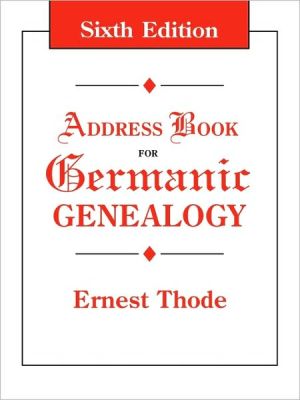

 |

|

The average rating for Address Book For Germanic Genealogy. Sixth Edition based on 2 reviews is 5 stars.
Review # 1 was written on 2015-07-11 00:00:00 Mark Barnes Mark BarnesA pretty thorough view of the Victorian censuses. In addition to a solid introduction to each census, useful to beginners and advanced students alike, case studies are used to illustrate the potential difficulties of locating ancestors in the name indexes. The focus is of course on Internet research and each of the online providers is analysed for strengths and weaknesses. My one criticism is that despite being only a couple of years old, references to online search engines for Findmypast and Ancestry are out of date. Things have moved on apace and you can search in ways not possible at the time of publication. |
Review # 2 was written on 2015-07-18 00:00:00 Shawn Harrison Shawn HarrisonYour Swedish Roots is the first book in written in English by Per Clemensson and Kjell Andersson, experts on this topic and authors of many on the subject in Swedish. The earlier definitive work on Swedish genealogy (there is only one), Cradled in Sweden (Everton Publishing, Provo UT, Revised Edition 1995), by Carl-Erik Johansson (1917-2000) is pre-Internet and even pre-CD. There are other differences between the two books. As one grows as a Swedish researcher, it makes sense to own and use both. Cradled in Sweden is a reference work - it is not easy to read. It contains the detailed information that is sometimes handled in Your Swedish Roots by directing readers to web sites. For a newcomer, Your Swedish Roots is an excellent and inviting resource. While not ignoring the complexities of Swedish research, this book, by introducing approaches to finding the place of origin in Sweden and laying out thoughtfully chosen case studies, guides the reader through the processes. The book is rich with knowledge. It can pretty much be read straight through and referred to later on. Its strengths include many images that take one back to the ancestral lands, and logical comprehensive treatment of primary records. There are plenty of photographs and drawings of farmhouses, churches, and the ships that transported so many Swedish emigrants to America. Transcriptions of Old Swedish and translations into English accompany reproductions of birth, marriage, death, and household examination records. Preprinted forms were used even several hundred years ago. I personally have struggled with the headings on many such forms and was pleased to find example translations and explanations. For Americans of Swedish decent the details about life in Sweden are illuminating. One picture shows a pre-1900 bride in a black dress, "practical since she could use it for other occasions." Drang and Piga are terms denoting an individual's occupation and social status that appear it seems in most Swedish marriage records. In Your Swedish Roots, these are general terms meaning young man and young woman, respectively. In Cradled in Sweden they come out as farm hand and maidservant. I accept both sets of definitions even though the former has the hint of political correctness. The authors stress flexibility. Even though a parish is named in a record, it may not be the parish where the individual was born and raised. In the 1879 passenger list of the Steamship Orlando, Gustav Adolf Rapp's birthplace is incorrectly given as Carlsborg parish in Skaraborgs province. The authors show other records that refute that information: Gustav was born in Ransberg parish. This book is blatantly welcoming. Its final chapters (14 through 17) are devoted to researching in Sweden, traveling in Sweden and "meeting the Swedish family." Chapter 17 is a smorgasbord covering all of Sweden's provinces. It was the only part of the book I could not breeze through, more reference material than prose. Helpful appendices include a dictionary of Swedish words in frequent use in parish records, abbreviations used in the records, and a list of genealogical societies in Sweden. Per Clemensson and Kjell Andersson are responsible for good work. They open the door for many Swedish-Americans interested in family history. There is room for a sequel or two with additional case studies. These might go further back in time with records of the 1600s and 1700s or feature some examples very rich in historical detail. Tongue in cheek - a few titles come to mind: Your Swedish Rootsson, Mor Your Swedish Roots, and Mormor Your Swedish Roots. Books about Sweden in English are pretty hard to come by. In my own small collection of rare finds, Your Swedish Roots finds a welcome spot next to The Soul of the North (2000) by Neil Kent and This Land of Sweden (1946) by Prince William. |
CAN'T FIND WHAT YOU'RE LOOKING FOR? CLICK HERE!!!